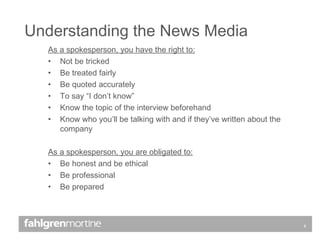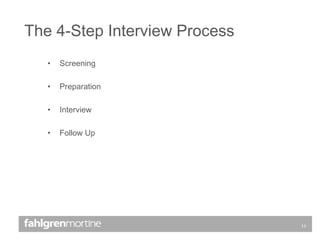Media Relations 101
- 1. INTRO TO MEDIA RELATIONS
- 2. UNDERSTANDING THE NEWS MEDIA
- 3. Understanding the News Media Media relations – Refers to a relationship that an individual or organization develops with journalists Informing the public of an organization’s mission, policies and practices in a positive, consistent and credible manner Broadly divided into proactive and reactive activities Public relations – Extends that relationship beyond the media to the general public Gains an organization or individual exposure to their audiences using topics of public interest and news items that do not require direct payment It also offers third-party legitimacy that advertising does not have
- 4. Understanding the News Media Purpose of media relations: To build awareness through third-party sources To create understanding of an issue or position To develop public image; foster goodwill toward the organization To publicize a new product or service The role of media: To tell THE story, not to tell YOUR story
- 5. Proactive Media Relations: Stories initiated by the company and/or the agency News releases Bylined articles Case studies Expert source pitches Human interest stories Social Media Editorial calendar opportunities Crisis Media Relations: Stories initiated by the reporter that may not be favorable toward the company or that result from conditions beyond the company’s control Understanding the News Media
- 6. What is news? Is it new Is it unique Is it the first Is it timely Is it the only Is it local Understanding the News Media
- 7. Understanding Media Lead Times Daily newspapers (4 p.m. night before) Weekly newspapers (2 days to a week before) Television (same day to two weeks) Radio (same day to two weeks) Online (immediate) Understanding the News Media
- 8. As a spokesperson, you have the right to: Not be tricked Be treated fairly Be quoted accurately To say “I don’t know” Know the topic of the interview beforehand Know who you’ll be talking with and if they’ve written about the company As a spokesperson, you are obligated to: Be honest and be ethical Be professional Be prepared Understanding the News Media
- 9. As a spokesperson, you DO NOT have the right to: Say things “off the record” Review an article before it goes to print/airs Speak about topics or issues you are not educated on Disclose private information about the company, its employees, its agents, its customers or its vendors unless approved in advance Understanding the News Media
- 10. Understanding the News Media Do’s and Don’ts of Media Relations Do: Treat this as a business relationship Rehearse Remember to use key messages Speak in sound-bites Be memorable Know the media will talk to your competitors Respect deadlines Provide detail
- 11. Understanding the News Media Don’t: Keep talking to fill silence Speculate Talk too fast Forget: Everything you say can and will be used in print Bad mouth anyone
- 12. The 4-Step Interview Process
- 13. Screening Preparation Interview Follow Up The 4-Step Interview Process
- 14. The 4-Step Interview Process Screening Ask questions about the interview Topic Deadline Contact information Publication Stall, if necessary This isn’t a good time. Can I call you back this afternoon or tomorrow? Do NOT get pushed into an instant interview Determine if you want to do the interview in-person or over the phone Contact your agency to make them aware of the opportunity. In most cases, media should be referred to your communications leader.
- 15. Screening Research the reporter Do they usually cover this topic or beat Have they covered organization before Was it a positive story or experience What is their background Research the publication Is this a tier one, tier two or tier three media outlet What is the audience (agents, customers, employees) Determine the appropriate spokesperson Are you the expert Is there someone else that is more appropriate for the topic or audience of the publication The 4-Step Interview Process
- 16. The 4-Step Interview Process Preparation Analyze the reporter’s request to further your own communications objectives by writing down: 2 – 3 key messages you want to convey 2 – 3 difficult questions you’re likely to face and how you would answer them Get your surroundings ready Reserve a space for the interview where you won’t be interrupted Gather any supporting materials or relevant press information Get yourself ready Rehearse key messages, particularly if this is for a broadcast interview Review statistics, dates or other information you want to convey Take a deep breath
- 17. The Interview Avoid: Hallway interviews Lunch interviews Interview during happy hour or over cocktails Interviews during private events Do: Set ground rules up front Outline any topics that are off-limits Communicate any time constraints up front The 4-Step Interview Process
- 18. The 4-Step Interview Process A good answer: States or restates the question Gets right to the point Is conversational and sincere Uses relevant facts, figures and names Doesn’t use industry jargon Is informational, not promotional Uses visuals to clarify a point, as available Is truthful If you don’t know, say so. If you make a mistake, correct it. Never speculate. Don’t lie.
- 19. The 4-Step Interview Process Positive Vs. Negative Language Word choice during an interview can be critical in helping to ensure your words don’t get misquoted or your thoughts misrepresented. Avoid negatives, absolutes and statements that place blame Choose positive, more flexible words and statements Use power words that describe action or invoke emotion/feeling Valuable Lessons Mistakes Differences Faults Unwise Bad Could have Should have Seldom Never Often Always Situation Problems Instead use… Avoid…
- 20. The 4-Step Interview Process Controlling the Interview Bridge from a question or topic to the answer/message you want to give From my perspective … Let’s talk about something I am even more familiar with … Briefly answer the question, but quickly move to a message you’d like to give Yes, but … Pose a new question and answer it yourself The real question here is “what are we doing about the problem.” The heart of the matter really is “what we are doing about the problem” Stop talking Reporters often leave uncomfortable gaps of silence to get you to fill the space
- 21. The 4-Step Interview Process Responding to difficult or inappropriate questions Stay calm Don’t show panic – by laughing, avoiding eye contact or body language Take a deep breath and collect your thoughts Don’t be defensive Use pre-determined lines to buy you some time or to address the nature of the question I wasn’t prepared to talk about that today. I can send you some additional information on this topic. I’m not sure how this question is relevant to the topic at hand. Can you elaborate on the question? I’m not familiar with the issue/situation and am not equipped to discuss this.
- 22. The 4-Step Interview Process Follow up Discuss how the interview went with a member of communications or the agency Were you able to include key messages Were there any errors in the information provided What was the tone of interview What questions were asked Is follow up needed Do you know when the piece is expected to run Make any corrections or clarifications immediately following the interview
- 23. The 4-Step Interview Process Follow up What if there is an error or mistake? It is appropriate to promptly address a factual error or mistake Be aware that print retractions and corrections are usually tiny and are not immediate Online edits can usually be made in real-time What if the article is negative? Be cautious Assess how much damage is really done Address an issue first with the reporter you spoke with Don’t risk ruining a good relationship Use your communications leader to handle this matter
- 24. QUESTIONS? Mike Hogan Media Relations Specialist Phone: 614/383-1617 Email: mike.hogan@fahlgren.com























